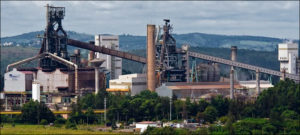Sep 15, 2020Before implementing a radio frequency identification solution, Gerdau, located in Ouro Branco, Brazil, had used barcodes to identify products. The company is currently in the process of migrating to RFID inlays, though it plans to keep using barcodes as a contingency. RFID is used for receiving, shipping and inventory tracking, reducing the risk of human error, according to Márcio Kiyoshi Ouchi, Gerdau's site logistics manager. In the process of receiving and shipping products, the firm must scan labels individually, using a manual data collector. "After implanting RFID," Ouchi says, "we will use crane readers and RFID collectors, which can read all desired products with just a single command."
The main benefits that the company expects to achieve relate to the safety of workers involved in the process of receiving products on the floor, and to enhancing crane and forklift operation. According to Ouchi, Gerdau expects to increase inventory control and warehouse management, and to optimize its internal logistics processes, thereby boosting employee productivity. The company also expects to reduce its overnight rates due to reduced loading times for trucks and wagons, with fewer customer complaints regarding product shipping errors.

Gerdau's factory in Ouro Branco
"We were able to increase the use of assets such as trucks, forklifts and cranes," Ouchi says. "During shipping processes, it is necessary to climb on trucks and wagons to collect materials. After our RFID implementation, that will not be necessary, since the loading and reading of products will take place automatically."
The inventory-management process will show productivity gains, Ouchi predicts. "Currently, it is necessary to read products tag by tag, and to move materials that are in high stacks," he says. "After the RFID implementation, we will perform mass inventory counts without the need to move products." The RFID deployment follows GS1's EPC Class 1 Gen 2 standard. "The greatest benefit will be the ease of traceability of Gerdau's products and assets that are moved to other locations, such as other plants or business units."
Fixed readers are installed on overhead cranes, forklifts and portals for reading vehicles and associating their loads, while mobile readers will be used for ground operations. "The readers are from several brands, such as Impinj, Zebra, Acura and some other brands, with a total of 40 readers," Ouchi explains. The tags are provided by CCRR, HID and Omni-ID.
"A series of challenges have occurred since the first pilot in 2017," Ouchi recalls, "because the environment is extremely metallic and with very limited distances between products. To ensure the fidelity of the readings associated with the speed and agility of the movements, some strategies were adopted, such as reading filters, business rules and studies on the positioning of antennas." The RFID solution is integrated with the company's SAP enterprise resource planning (ERP) system, hosted on local servers.
"Traceability will be present in the entire logistical process of wire rod and structural profile products for the Ouro Branco unit," Ouchi says, "and will go through all the processes mapped in the solution's BluePrint. Among the processes, we will have traceability in the birth of the product for logistics (receipt), its movements, picking orders (loading), inventories and processes related to the business, such as item reclassification, code change and other processes."
"The solution will begin with the reading of the label when it is attached to the product," Ouchi adds, "and all its movements and procedures will be captured by RFID via portals, forklifts, overhead cranes and collectors. In turn, all operations captured by RFID will be integrated with SAP and other systems, speeding up the entire logistics process."
Through the RFID middleware, it will be possible to read and associate products and addresses, consolidate second-level interface communication—PLC, MES and so forth—and promote the management of data and information capture points. Ernst Young (EY) is Gerdau's partner in implementing RFID "EY's delivery methodology contains a series of dimensions that cover the needs of each business," Ouchi states.
"Even though it is a single plant in Ouro Branco, the business rules for the logistical operations are not always equivalent to that of wire-rod products," he adds. "This will make it possible to deliver the results without a main supplier for the solution, as each member of the solution will have its function defined in the EY framework and the possible impacts among the solution's members." Gerdau and EY have a relationship on technology projects going back more than 10 years, ranging from global SAP implementations to demand management and more. EY has provided partnerships and solutions with an agnostic approach based on Gerdau's needs.
"All projects that combine innovation, operational process changes, organizational changes, technologies and major infrastructure projects challenge everyone involved in the project," Ouchi says. These are challenges such as new technical knowledge, deepening of processes and their exceptions, involvement with different areas and departments with different responsibilities and priorities. Gerdau has innovation and the search for performance in its DNA, and it understands that this process, when well founded and executed, is very positive."

